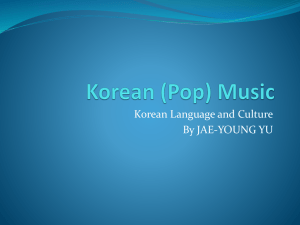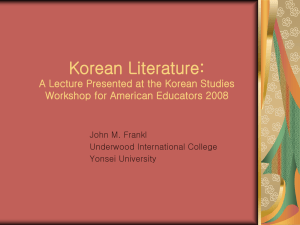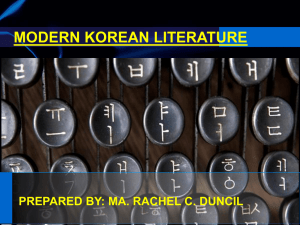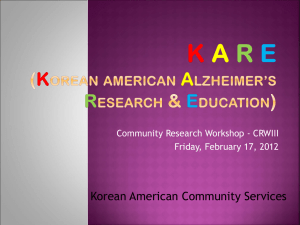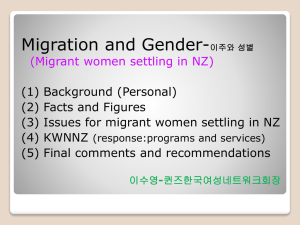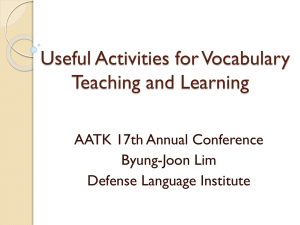haighBilingual-Program-2013
advertisement
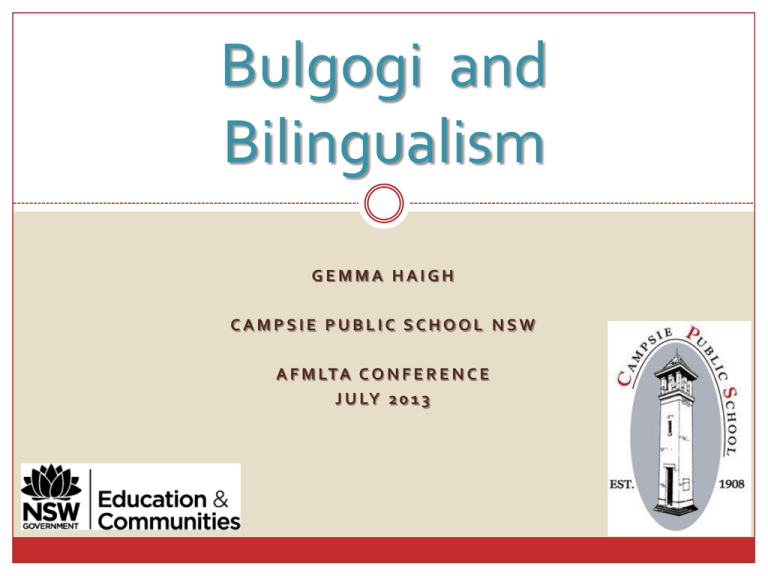
Bulgogi and Bilingualism GEMMA HAIGH CAMPSIE PUBLIC SCHOOL NSW A F M LT A C O N F E R E N C E J U LY 2 0 1 3 Campsie Public School is one of four NSW bilingual schools. The school’s language focus is Korean and the language is taught each day to selected classes. The bilingual program is offered as an option alongside the traditional curriculum. School Profile Campsie Public School is a large primary school in the inner w e s t o f S y d n ey, i n t h e c i t y o f C a n t e r b u r y, N S W. The city is home to over 130 nationalities, with a majority of its residents being born overseas. The school serves a diverse multicultural community where 97% of the students come from a non -English speaking background and 42 languages are spoken by the school c o m m u n i t y. 720 students 39 different nationalities 12 different languages taught at school 5% Korean language background The Bilingual Program is one element in a comprehensive whole school approach to language studies and Asian Literacy. Korean Bilingual Program – introduced in 2010 12 Community Languages – Korean, Chinese, Vietnamese, Arabic, Indonesian, Hindi, Punjabi, Bengali, Fijian, Samoan, Tongan and Rarotongan. Korean Connected Classroom Program introduced in 2011 through ConnectKorea – Becoming Asia Literate Grant Established a sister school relationship in Busan, South Korea in 2013 through KoreaAusConnexion Project Established a sister school relationship in Cheongju, South Korea in 2013 through AEF Bridge Project Philosophy and Vision built up Asian languages programs delivered creative solutions in delivering sustainable language education programs ensured Asia prepared teachers and school leaders c r e a t e d t a s k f o r c e t o e m b e d A s i a a n d A u s t r a l i a ’s e n g a g e m e n t with Asia in classroom curriculum built awareness and demand for Asia skills among parents and students Enacting an Asia Literacy action plan Asia literacy perspectives – current and new curriculum Asia focused resources and events Preparing teachers and leaders in Asian languages and cultural understanding 5 teachers undertaking Graduate Diploma Modern Languages through Primary Asian Language Training Scholarship Program 2011 - 2013 3 teachers attended South Korea Teacher Education Visit 2011 12 teachers completed Graduate Certificate of Teaching Asia 2011-2012 Teaching of Asian Languages 4 of the 5 national priority languages taught (Chinese, Indonesian, Hindi and Korean) as well as other non-priority Asian languages (Vietnamese, Punjabi, Bengali, Arabic and Pacific Islander) Korean Bilingual Program Innovation – sharing resources, partnerships The initiative has been prompted by the need to increase the number of students achieving fluency in priority Asian languages. It reflects Asia's importance to Australia's future economic and social prosperity and the likelihood that many Australian workers will need to be comfortable in the use of an Asian language. The program is also a response to the increasing number of parents wanting to send their children to a primary school offering a strong Asian language program. The program is expected to give primary students a head start on language studies in later years, improve their understanding of other cultures and, in the longer term, increase their job opportunities. It builds on a broad body of research which indicates that bilingual education stimulates intellectual development, generates greater flexibility in thinking, gives learners a better understanding of their first language, and develops listening skills. Curriculum Leadership Journal, 27 November 2009. Process The NSW Government invested $2.25 million over four years in the establishment of a Bilingual Schools Program for the four priority Asian languages: Indonesian, Japanese, Korean and Mandarin Chinese. Currently five classes (one class per grade in The study of languages at Campsie Public School provides opportunities for students to become more accepting of diversity, more respectful of others and better equips the students to engage with others and participate fully in a globalised world. Kindergarten, Year One, Year Two ,Year Three and Year Four) are being taught as bilingual classes, progressing to K-6 by 2015. These classes receive approximately 80 minutes per day Korean instruction. Korean is taught through the context of the thematic unit of the grade, focussing on the HSIE and Science outcomes. The Community Languages program at Campsie Public School ensures that students have the opportunity of acquiring, maintaining and developing a community language in Korean, Mandarin, Vietnamese and Arabic. The additional LOTE (Languages Other Than English) program includes 6 languages and focuses on developing language proficiency and promoting intercultural understanding. Currently twelve languages are taught with the aim that every student in the school will study a language other than English. Who with? • With Kindergarten and Year 1 only in 2010 • Expanding into the following years of primary school each year • Kindergarten –Year 6 in 2015 Who is teaching? • primary trained specialist language teachers, in conjunction with native speaking volunteers. • for one and a half hours each school day What and how? • direct and integrated language teaching and learning • team teaching with the class teacher in subjects such as HSIE, PDHPE and Creative Arts to extend the language learning environment within a balanced primary education program. Practice and Pedagogy ASIAN LITERACY SUPPORTING ENGLISH (SECOND LANGUAGE) ACQUISITION LO T E – E D U C AT I O N O F W H O L E C H I L D TE CHNO LO GY The school annually promotes Asian Literacy Week; engaging students, teachers and the parent community by helping to build skills and knowledge of Asia in all areas. The school celebrates Hangul day each October; showcasing student work, art and performances to the school, parent and local community. An annual school festival day – including food stalls, costume parade, dances and performances – highlights and celebrates the many nationalities of the school community. Classes regularly visit the Korean Cultural Education Centre. These visits provide an enjoyable learning experience while immersing students in the Korean culture. Continued and effective use is made of our video conferencing facilities, which allows staff and classes to link with other schools, as well as specialist facilities such as universities and art galleries. Through the Becoming Asian Literate Schools Grant, the school has developed an innovative program to teach Korean language and culture using ipads and Web2 tools. The Korean language program currently uses the connected classroom link to provide lessons, teaching Korean for one hour per week, to students of primary school age. The three schools involved are Merriwa Central School, Newington Public School and Juk-Seong Elementary School in Busan, South Korea. Class time • 5 hours p/w • 4 hours COGs & 1 hour LOTE • primary trained language specialist Extra Curricular Extra Curricular • Korean Traditional Dance or Drumming • Korean instruction • 40 min before school activity by the specialist • Taekwondo in • Korean instruction • 40 min before school activity by the master STAGE 2 SCOPE & SEQUENCE: AUSTRALIAN CURRICULUM Term EVEN YEARS Unit Outcomes Korean Focus CAPA PDHPE English 1 Information ST2-15I ST2-5WT Online safety and etiquette Dance Drama (ads) Safety Swimming Sun protection Persuasive Texts: advertising & review 2 Earth & Space Telling time, months of the year, seasonal changes Shadow & light art Informative: Explanation & procedure Mapping Time 3 First Contacts ST2-8ES ST2-9ES ST2-7PW ST2-4WS ST2-5WT HT2-3 HT2-4 HT2-5 Mythology of Dangun, the progenitor of Korean people Visual Arts before & after images Bush dancing Informative : Recount & narrative Mapping 4 Living World ST2-10LW ST2-11LW ST2-4WS Human life cycle, food chain Music Botanical drawings Informative: Information Report Imaginative: poetry Data (tables) Sport in Schools Child protection Maths STAGE 2 SCOPE & SEQUENCE: AUSTRALIAN CURRICULUM Term ODD YEARS Unit Outcomes Korean Focus CAPA PDHPE English Maths 1 Being Australian HT2-2 HT2-5 Aboriginal story Dance Values Swimming Persuasive Imaginative: aboriginal stories Data (graphs) 2 Local Environments ST2-14BE ST2-4WS ST2-5WT Designing a town Drama (team work) Road safety Persuasive: debate Informative: description Length & Area Mapping 3 Products & Machines Cookie factory, Bicycle from wheat to drawings/art cookies Safety & hygiene Healthy eating Drug education Informative: explanation & procedure Measurement: mass, V&C 4 Understanding Culture ST2-16P ST2-12MW ST2-13MW ST2-6PW ST2-4WS ST2-5WT HT2-1 Korean folk stories Group work Values & beliefs Sport in Schools Child protection Imaginative: traditional narratives Mapping Music: traditional songs Purpose and Outcomes "ONE OF THE MAJOR BENEFITS OF LEARNING A SECOND LANGUAGE IS THE STRAIGHT BRAIN P O W E R , T H E C O G N I T I V E P O W E R , T H AT A R I S E S … YOU END UP WITH BETTER OVERALL BRAIN FUNCTION AS A CONSEQUENCE OF THE CHALLENGE OF LEARNING AN ADDITIONAL LANGUAGE IN THOSE E A R LY P R E S C H O O L T O P R I M A R Y S C H O O L Y E A R S . “ IAN HICKIE DIRECTOR OF BRAIN & MIND RESEARCH INSTITUTE SYDNEY UNIVERSITY, NSW Assessment LOTE assessed by specialist language teacher HSIE/Science component assessed by classroom teacher Resources Present Position • I N C R E A S E D PA R T I C I PAT I O N I N B I L I N G U A L P R O G R A M • ENGAGEMENT OF STUDENTS • CONNECTION WITH COMMUNITY • O N G O I N G A N A LY S I S O F R E S U LT S • LO C A L , S TAT E , N AT I O N A L A N D I N T E R N AT I O N A L CONNECTIONS 2010 2011 2012 2013 Kinder Kinder Kinder Kinder 25 Year 1 23 Year 1 26 Year 1 49 Year 1 22 25 Year 2 25 Year 2 26 Year 2 22 24 Year 3 25 Year 3 18 24 Year 4 20 From the teachers “The bilingual program provides language skills as well as an understanding and respect of another culture.” “I’m amazed at the speed of language acquisition, particularly as for many students, this is their third language.” “This has been one of the best things to happen to our school; there’s a real buzz.” From the parents “Learning a new language has shown my son his true potential.” “All areas of learning have improved since his involvement in the program.” “I’m excited at the thought of how this will benefit my child’s future.” “My daughter now has a love of all things Korean!” From the students “I can sing and count in Korean, you know.” (Kinder) “I like Korean because I like writing the alphabet.” (Year 1) “Sometimes I play in Korean and other times in English.” (Year 2) “I like it that I can order in Korean at Korean restaurants now!” (Year 3) “I wanted to learn Korean because of K-pop but now I want to learn so I can speak another language.” (Year 4) Post 2013 • S U S TA I N A B I L I T Y O F L A N G U A G E P R O G R A M S • I N C R E A S E D PA R T I C I PAT I O N I N B I L I N G U A L P R O G R A M • O N G O I N G A N A LY S I S O F R E S U LT S • FEEDER HIGH SCHOOLS TO INCLUDE LANGUAGE PROGRAM • SCHOOL FUNDING OF PROGRAM; BUILDING ON CURRENT C A PA C I T Y • I N C R E A S E O F N S W S T U D E N T S L E A R N I N G KO R E A N A bright and colourful future
